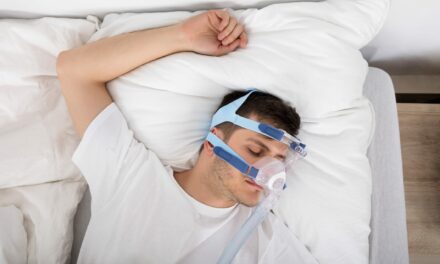Humidity is beneficial to a healthy airway, and when CPAP is used without this feature, many patients’ airways can be jeopardized.

WHAT IS HUMIDITY?
In order to understand the importance of humidity for the airway and CPAP, it is necessary to understand humidity. Humidity is water in its vapor form.4 Absolute humidity is the content of water vapor in the air,4,5 whereas relative humidity (RH) percent is a ratio of the actual water vapor present in a gas and the capacity to hold the vapor at a given temperature.4,5 The capacity of a gas to hold water in its vapor state increases as temperature increases, thereby increasing the absolute humidity of the inspired gas.4 When the content of humidity is equal to the capacity, then the RH is 100% or saturated.4 When the air is saturated with water, the dew point has been reached.4 Once the dew point is reached, visible water droplets begin to condense on surrounding objects, such as in the tubing used with CPAP and heated humidifiers. Rakotonanahary et al6 established that the RH of the air delivered by CPAP is 20% lower than the RH of the surrounding air.
The drying effect of the CPAP airflow is known to increase airway resistance.2,7 Excessive drying of the airway by CPAP has been shown to increase the release of vasoactive leukotrienes, subsequently increasing nasal resistance.6 Resistance is the ratio between the driving pressure responsible for gas movement and the flow of the gas and is measured in cm H2O/1 sec.4 Airway resistance is the result of friction among molecules of a flowing gas and between the molecules of the conducting tube of the airway.4 When the airway is irritated or damaged, the flow of air becomes more turbulent partly due to the increased resistance. Increased nasal resistance is also thought to induce oral leaks.6
THE UPPER AIRWAY
The upper airway or respiratory tract is generally considered to be all the structures above the larynx, whereas the lower airway consists of the trachea and lungs.4 Complaints associated with CPAP are generally associated with the upper airway. After all, the nasal cavity is the gateway to the respiratory system. Dry air used with CPAP that is not adequately humidified may lead to such patient complaints as nasal/oral dryness, nasal congestion, rhinorrhea, sneezing, or epistaxis.1-3,6,7 Nasal symptoms are believed to be experienced by 30% to 70% of patients using CPAP.2,3,7
When discussing humidification of the airway, it is important to note that the warming and humidification of air begin in the nasal cavities.1,2,8 The nasal cavity volume and the temperature of the nasal mucosa are considered the most important predictors of nasal conditioning.8 These parameters determine the local heat and water exchange in the respiratory system.8 The mucous membranes, starting in the nasal passages, are supplied with large amounts of blood flow. It is the warming effect of the blood flow that helps to add humidity to the air on inspiration. An easy example of how effectively the airway humidifies air is to examine the amount of moisture in exhaled air.
The area within the nasal cavities is called the vestibule.4 The vestibule, mouth, and pharynx are lined with squamous epithelium.4 Above and behind the soft palate, the nasal cavities converge to form the upper portion of the pharynx and nasopharynx.4 The nasal cavities, sinuses, and much of the lower respiratory tract are lined with fine microscopic hair-like projections called cilia.4 The cilia act to project materials out of the airway. Lubrication of the respiratory tract is provided by mucus.4 Mucus is secreted by submucosal cells and individual cells within the mucosal lining called goblet cells.4 Mucus acts to trap foreign particles. When inhaled air is inadequately humidified, mucus becomes thicker and harder for the cilia to expel.3 A study investigating the effects of CPAP on the nasal mucosa performed by Constantinidis et al3 showed that the airflow generated by regular CPAP use caused morphological changes of the nasal epithelium. These changes are associated with a prolongation of mucociliary clearance and chronic inflammation of the nasal mucosa.
HEATED OR COOLED?
Three factors are related to the efficiency of a humidifier, including the amount of the surface area exposed between the water and the gas, the time the gas and water are in contact with one another, and the temperature of the water and the gas.4 The cold-passover humidifier is the simplest and cheapest type of humidifier. The ability of a passover humidifier to provide humidity is dependent on the evaporation of water when the gas is directed across its surface.4 The amount of humidity carried by the gas is increased when the gas or water is heated.4 When comparing heated humidifiers with cold passover, only a modest increase in the absolute humidity is witnessed with the latter.9,10 A study of 10 subjects performed by Randerath et al10 demonstrated that while cold passover humidifiers showed an increase of RH from 24% to 34.5%, heated humidification increased the RH to 53.9% +/-13.2%. Massie and coworkers2,7 reported that a study of 38 patients comparing no humidification to cold passover and heated clearly demonstrated the advantages of heated humidification. In fact, heated humidification was preferred by 76% of the study subjects and attenuated symptoms that reduce CPAP compliance.2,7
In the age of cost-effectiveness and cost cutting, many insurance companies are unwilling to pay the high cost of heated humidifiers, even when the research clearly demonstrates the benefit of heated humidification for use with NCPAP.1 Unfortunately, heated humidifiers can cost up to five times more than a cold passover.7 Cold passover humidifiers, although much less expensive, often do not add enough humidity to increase patient compliance.7 There are a number of other types of humidifiers; however, the passover humidifier, whether heated or not, is the primary design for home CPAP use. When attempting to justify heated humidification, several factors need to be addressed. Evidence clearly demonstrates that lack of humidification leads to nasal and oral discomfort and morphological changes in the airway that lead to poor patient compliance.3 When a heated humidifier is added, the RH within the airway is significantly increased and patient compliance with therapy increases.3
Although often helpful, humidifying CPAP often complicates the therapy, adding further responsibilities for the patient. The humidifiers must be properly cleaned and filled on a regular basis. If a humidifier is not cleaned properly, there is a risk of colonization and possible infection of the patient.10 Use of an empty humidifier increases the risk of pulmonary burns or damage to the nasal mucosa. Adding a humidifier may also increase the need for space and complicate travel.10 Heated humidification increases the potential for water accumulation within the CPAP tubing. A study performed by Bacon et al11 demonstrated that a stable mask pressure is not maintained when water accumulates within the NCPAP tubing. The accumulation of water in the CPAP tubing is known to produce large rapid fluctuations in mask pressure.11 Fluctuations of pressure are uncomfortable for the individual and subtherapeutic.11 It appears that the large rapid fluctuations with system resistance and the movement of the water in the tubing lead to inconsistent pressures.11 Bacon believes that water condensation in CPAP tubing is the most important factor causing subtherapeutic pressures that can be controlled.11
MOUTH LEAKS AND FULL FACE MASKS
Mouth leaks are thought to be associated with upper airway symptoms. The increased nasal resistance caused by the drying effect of the air delivered by the CPAP unit is a contributing factor leading to oral leaks.1,2 Mouth leaks produce high unidirectional airflow over the nasal and oral mucosa.1,11 The unidirectional airflow increases a patient’s feelings of mouth and nose dryness, and nasal congestion.1,11 Mouth leaks result in an increased release of inflammatory mediators and increased nasal mucosal blood flow.2 If a heated humidifier alone is unable to eliminate oral leaks and upper airway discomfort, then a full-face mask is often employed.
Full-face masks are able to reduce CPAP-related nasal symptoms.1 A study performed by Martins de Araujo et al1,12 showed that the use of a full-face mask prevents changes in RH that may lead to water loss within the airway. The full-face mask was shown to be the best choice to reduce problems associated with oral leaks and/or contributing to nasal discomfort.1,12 Unfortunately, a large percentage of individuals who attempt to use a full-face mask are unable to tolerate the mask. Much of the patient discomfort is caused from the mask being improperly applied.12 When a patient is effectively educated and the mask is fit properly and used with a headgear designed specifically for it, full-face masks are very effective and often tolerated well.12 Martins de Araujo et al1 demonstrated that when heated humidity and a full-face mask were used together, the decrease in RH was totally eliminated.
CONCLUSION
Patient-perceived benefits from CPAP are the single most important factor for successful CPAP therapy11; however, with the incidence of nasal discomfort associated with the drying effect of CPAP approaching 70%, CPAP compliance and the perceived benefits are sorely limited. Heated humidifiers are the best choice to increase comfort, reduce nasal symptoms, and increase compliance. Unfortunately, insurance companies are sometimes unwilling to pay the high cost of a heated humidifier. Cold passover humidifiers are considerably less expensive and may benefit individuals without adverse nasal symptoms, but are of little help for those individuals suffering CPAP-related upper airway discomfort. The need for heated humidification can be justified by demonstrating the high percentage of nasal discomfort, morphological changes to the airway, and poor patient compliance without it. The current research supports the benefit of humidity when added to CPAP. When the addition of heated humidity alone does not eliminate problems associated with CPAP use, then a full-face mask is an excellent option. Heated humidification along with a full-face mask may completely eliminate water loss in the airway when CPAP is used.1 Humidity is essential for a healthy airway, and when CPAP is used without added humidity, the health of the airway is clearly in jeopardy for a majority of CPAP users.
Megan Rauch, RRT, is a respiratory care practitioner and sleep specialist at Mott Children’s Hospital and the General Research Center at the University of Michigan Medical Center, Ann Arbor.
References
1. Martins de Araujo MT, Vieira SB, Vasquez EC, Fleury B. Heated humidification of face mask to prevent upper airway dryness during continuous positive airway pressure therapy. Chest. 2000;117:142-147.
2. Massie CA, Hart RW, Peralez K, Richards GN. Effects of humidification on nasal symptoms and compliance in sleep apnea patients using continuous positive airway pressure. Chest. 1999;116:403-408.
3. Constantinidis J, Knobber D, Steinhart H, Kuhn J, Iro H. Fine-structural investigations of the effect of nCPAP-mask application on the nasal mucosa. Acta Otolaryngol. 2000;120:432-437.
4. Spearman CB, Sheldon RL, Egan DF. Egan’s Fundamentals of Respiratory Therapy. 4th ed. St Louis: CV Mosby Company; 1982.
5. Reinikainen LM, Jaakkola JJ. Significance of humidity and temperature on skin and upper airway symptoms. Indoor Air. 2003;13:344-352.
6. Rakotonanahary D, Pelletier-Fleury N, Gagnadoux F, Fleury B. Predictive factors for the need for additional humidification during nasal continuous positive airway pressure therapy. Chest. 2001;119:460-465.
7. Brown LK. Back to basics: if it’s dry, wet it: the case for humidification of nasal continuous positive airway pressure air. Chest. 2000;117:617-619.
8. Lindemann J, Leiacker G, Rettinger T, Keck T. The relationship between water vapor saturation of inhaled air and nasal patency. Eur Respir J. 2003;21:313-316.
9. Wiest GH, Harsch IA, Fuchs FS, et al. Initiation of CPAP therapy for OSA: does prophylactic humidification during CPAP pressure titration improve initial patient acceptance and comfort. Respiration. 2002;69:406-412.
10. Randerath WJ, Meier J, Genger H, Domanski U, Ruhle K-H. Efficiency of cold passover and heated humidification under continuous positive airway pressure. Eur Respir J. 2002;20:183-186.
11. Bacon JP, Farney RJ, Jensen RL, Walker JM, Cloward TV. Nasal continuous positive airway pressure devices do not maintain the set pressure dynamically when tested under simulated clinical condition. Chest. 2000;118:1441-1449.
12. Rauch M. Making CPAP work. RT: The Journal for Respiratory Care Practitioners. 2003;16(3):42-44, 57-58.





